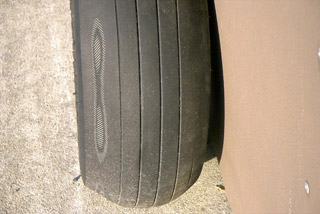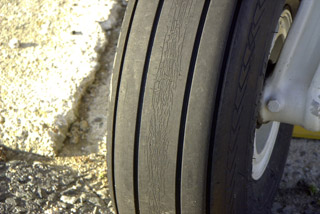From touchdown to tiedown: Aircraft tires
What’s between you and the runway?
They sit immobile, baking in the hot sun or hardening in the freezing cold for weeks at a time until they’re called upon to go from 0 mph to 60 mph faster than any earth-bound speedster. And, although it is one of the most stressed components of the average general aviation aircraft, it is often the most undervalued.

Every landing requires aircraft tires accelerate from standing still to touchdown speed in the blink of an eye. The best of landings exert significant twisting forces between the tire tread and bead as the tire accelerates to touchdown speed. Add a crosswind component and the accompanying side loads, and it’s easy to understand why aircraft tires must be manufactured to the highest standards.
Your tires should be a focal point during your preflight inspections. It’s very important to verify that your tires are in excellent condition with frequent inspection, especially after difficult landings. A good tire inspection includes a close examination looking for cuts, worn spots, bulges, foreign objects embedded in the tread, and general tread wear.
Some tire manufacturers publish minimum tread depths, which mandate tire replacement. As a general rule, if the tire tread has been worn to the base of any groove anywhere on the tire, it should be replaced. Additionally, if any of the inner fabric structure is showing through the tire tread, the tire needs to be replaced , regardless of the tread depth; this is a very serious condition.
 If the tire’s inner fabric structure is showing, you should replace the tire immediately.
If the tire’s inner fabric structure is showing, you should replace the tire immediately.
If you find cuts in the tire, it’s important to make sure that they haven’t cut into the ply of the tire. Any deep cuts extending more than half the width of a rib and deeper than 50 percent of the remaining tread depth are indications for tire replacement. Also, any bulges in the tread, sidewall, or bead area should be a reason to condemn the tire right away. These are often signs that the structure of the tire has separated or been damaged. Exposure to the sun and aging can also damage a tire. This is called weather checking and usually shows up as numerous small cracks in the sidewall and bead areas, but it can also occur right in the tread. As with cuts, cracks extending down to the plys of the tire should mandate tire replacement.
Another common tire problem is flat spots on the tread—often caused by skidding or hydroplaning during landing. Generally, tires do not need to be replaced due to flat spots unless the wear exposes the tire fabric. That said, flat spots can cause the tire to be out of balance. If you experience shimmy during taxiing or gear vibration in flight, examine the tires for flat spots and consider tire replacement to eliminate balance issues as the cause.
Next, take a close look at the bead area of the tire (where the tire meets the wheel rim). This part of the tire can be damaged by excessive heat from the brakes and should be smooth and free of cracks.
 Exposure to sun or the aging process itself can cause weather checking.
Exposure to sun or the aging process itself can cause weather checking.
Finally, examine the tread wear for evenness. If the tread is worn in the center, but not on the edges, the tire is probably over-inflated. On the other hand, if the tire shows much more wear on the edges, it’s probably under-inflated. Monitoring the air pressure of your tires is extremely important. Since aircraft tires and tubes are primarily made of natural rubber, they can lose pressure over time. Incorrect tire pressure can lead to uneven wear, excess heat generation, and reduced traction.
Aircraft tires are manufactured to extremely high standards. They can withstand a surprising amount of abuse and still return you safely to earth and your tiedown. However, they should not be neglected. Be sure to check your air pressure on a regular basis and perform inspections during every pre (and post) flight.
If your inspection reveals that it’s time for a change, roll up those sleeves because we’ll be covering tire selection and installation in our next installments!
Jeff Simon is an A&P mechanic, pilot, and aircraft owner. He has spent the last 14 years promoting owner-assisted aircraft maintenance as a columnist for several major aviation publications and through his how-to DVD series: The Educated Owner. Jeff is also the creator of SocialFlight, the free mobile app and website that maps over 5,000 aviation events happening throughout North America. Free apps available for iPhone, iPad and Android, and on the Web.



